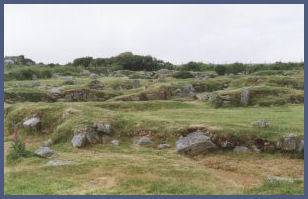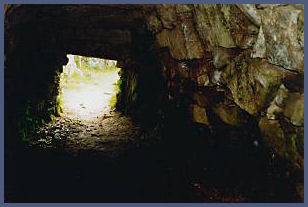Carn Euny
OS grid ref:-SW 403 288
 The ancient remains of the Iron Age village or farmstead of Carn Euny near Sancreed, 4 miles west of Penzance, are fascinating and well worth a visit.
The ancient remains of the Iron Age village or farmstead of Carn Euny near Sancreed, 4 miles west of Penzance, are fascinating and well worth a visit.
Similar to the Iron Age remains at Chysauster and owned by English Heritage, Although there is some little evidence of late-Neolithic and Bronze-Age settlement, the site dates between 500 B.C. and 400 A.D. Occupation of the site appears to have ended around the end of the first century AD.
The site consists of the rermains of several grass covered courtyard houses which each have a  series of chambers accessed from a central courtyard.The floors are of compacted clay and broken rock, containing hearths and clay-lined storage pits. There is evidence to suggest that the inhabitants of Carn Euny were farmers and tin dealers.
series of chambers accessed from a central courtyard.The floors are of compacted clay and broken rock, containing hearths and clay-lined storage pits. There is evidence to suggest that the inhabitants of Carn Euny were farmers and tin dealers.
An underground fogou, or tunnel (the word is Cornish for cave) stands at the centre of the site. The fogou is 60 feet (18metres) long and very well preserved. The entrance to the fogou stands at about three feet high. Its function is unfortunately unknown, but it may have been a cattle byre, cold-store or some other type of storage chamber, or it may possibly have served some ritual religious purpose.
A well and the remains of its associated chapel lie a short distance to the west of the settlement. There are two wells at the site, on either side of the path. The southern well has a few steps leading down to it, and the northern is surrounded by several large stone slabs. The surrounding trees are often decorated with clouties (small strips of cloth). The tradition dates back to pagan times, and says that if an ill person hangs a cloutie at a holy well, and either bathes in the water or drinks it, then as the cloutie disintegrates the illness will pass.
Directions
Carn Euny lies 1 1/2 miles to the west of Sancreed along narrow but signed lanes.